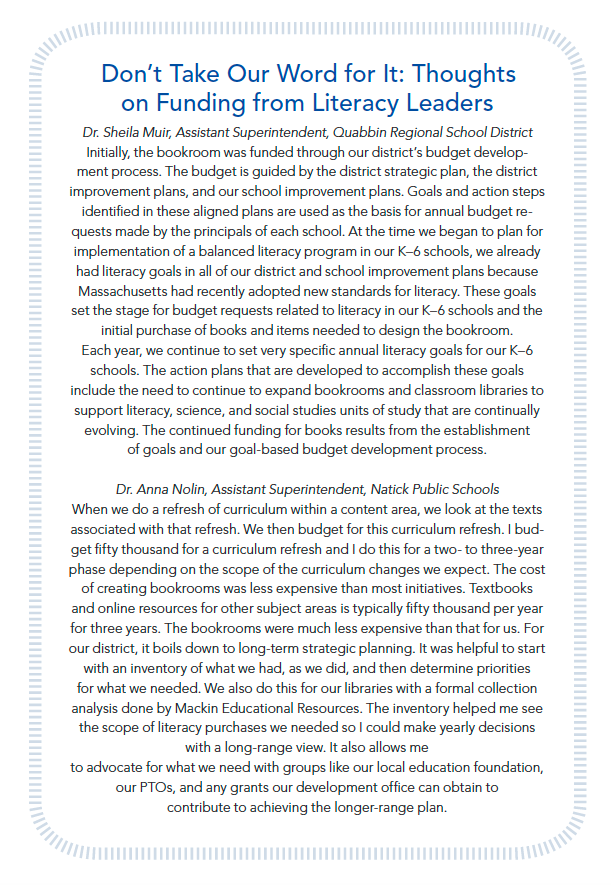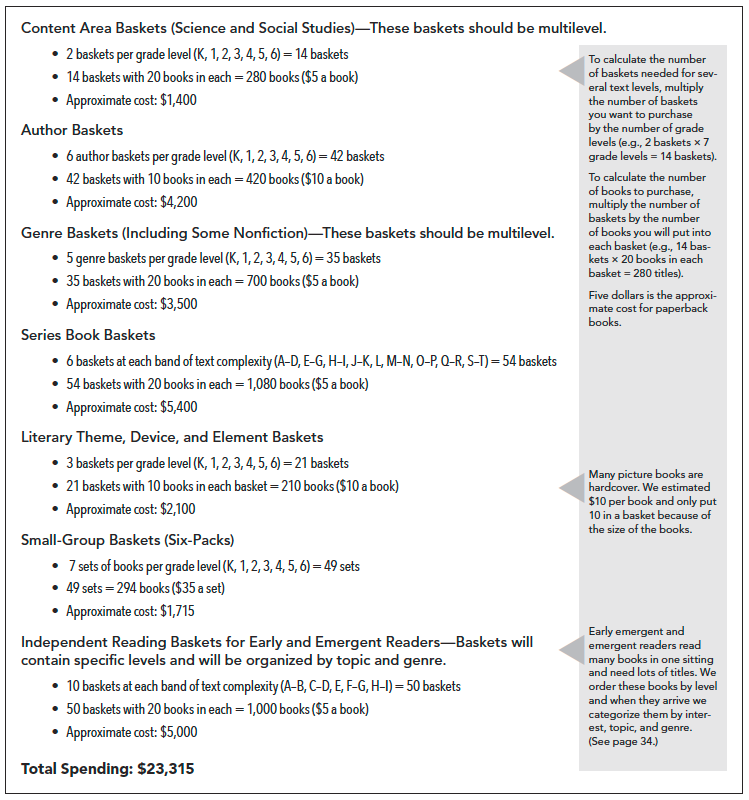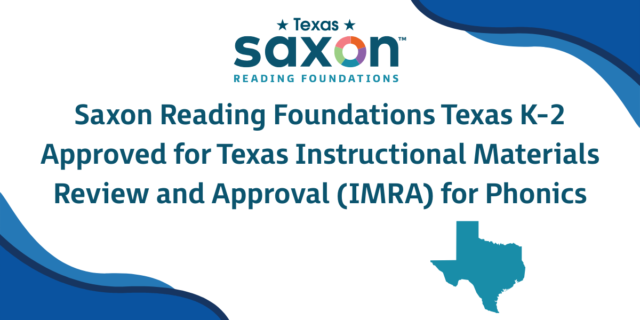
The term lifelong reader is more than a slogan or jargon in a mission statement. Lifelong readers need passion, agency and instruction – and they also need books! According to the American Library Association, classroom libraries (alongside well-stocked school libraries) should include about 300 titles. Fountas and Pinnell recommend that each classroom library has between 300-600 titles. Kelly Gallagher writes in his ground-breaking book, Readicide, “If we are to have any chance of developing a reading habit in our students, they must be immersed in a K¬-12 ‘book flood.’ ” Developing lifelong reading begins with books and we, as educators, have the power to make a school’s book supply seem endless in the eyes of its readers.
We have been partnering with school districts as literacy consultants for the past fifteen years. We find that 90 percent of the time, when a superintendent asks what he or she should do to get the desired academic results, we reply, “Fire us and buy some books.” We find again and again that teachers do not have the tools they need to bring the research on literacy best practices to life. The good news is, no one has ever fired us AND they find the money to get the books.
We know it is that time of year when budgets are due. We believe books need to be a line item on every school budget. If we design curriculum and progress-monitor our students, but don’t have a wide variety of books for students to read, these initiatives will fail. Books matter – we cannot teach literacy without authentic literature in classroom libraries, bookrooms, and school libraries. We know budgets are tight, but the time is now for schools to prioritize the funding of purchasing books so all students have the opportunity to be lifelong readers.
Don’t take our word for it! Here’s how two literacy leaders figured out how to make books a line item in their budget.
 * * *
* * *
Ready to get started?
1. Calculate the Number of Books You Need
We are often asked, “How much money does a school need for books?” We wish there was one answer, but of course there isn’t. It depends on the number of books you currently own, the condition and age of these books, and the number of students and teachers in the building.
To begin calculating what you need, here are a few figures to help you get started:
- Each K-1 students reads approximately five to seven books per week.
- Each 2-3 student reads approximately two to three books per week.
- Each 4-6 student reads approximately one to two books per week.
If the school year is thirty-five weeks long, you can estimate the number of books to purchase for each grade level. For example, if there are 80 students in kindergarten and first grade (4 classrooms) those students will read approximately 400 books a week (80 K/1 students x 5 books per week). If you multiply this number by thirty-five weeks in a school year it totals 14,000 books. Now, we can only dream of having that many titles! If you can afford this, go for it! But if you are like most of our partnership schools, your budget is tight. This is why we recommend teachers share texts across classrooms. Let’s look at how these numbers change when teachers share books.
When you create shared book collections each class will need the number of books 5-7 students will read over the course of a year. In our example above that means that the kindergarteners and first graders need 700 books ( 20 K/1 students X 35 weeks = 700 books). Of course, these numbers are estimates but they can help you create a realistic budget.
2. Calculate the Approximate Cost
To calculate costs, we estimate $5.00 per paperback and $10.00 for each hardcover when we design a budget. To help you know what types of texts to purchase, (i.e. series, books for genre, author, and content area studies) we use the sample ordering guide (insert Figure 5.1 below) and create our own. Creating an ordering guide will help you categorize the budget across grade levels, by text complexity levels, and by type of text.

You will notice on the sample ordering guide, that we purchase books to go into baskets. These baskets typically contain twenty individual titles of paperbacks or ten hardcopy books. Housing the books in baskets makes it easy for teachers to grab some baskets, add them to their classroom library, and then swap them for different baskets in a few weeks.
Here is a sample ordering guide for early and emergent readers in the four kindergarten and first grade classrooms we discussed above:
- 7 baskets at each band of text complexity (A-B, C-D, E, F-G, H-I) – 35 baskets
- 35 baskets with 20 books in each = 700 books ($5 a book)
- Approximate cost: $3,500
Now, we can give this portion of the budget to our literacy specialist, school librarian, and K/1 kindergarten teachers so they can begin shopping.
3. Don’t Forget
Take it from two women who have learned lessons about budgeting the hard way, here are a few tips:
- Budget for and order baskets, shelving, and basket labels. Here are some suggestions for purchasing durable baskets (from online resource 3.1 from our book):
- Booksource
- Really Good Stuff
- Sterilite Book Bins (available at Target, Walmart, Amazon, etc.)
- This is not a one-time deal. New books are published every year and readers want to read “hot off the press titles.” Keep a line item for books in your budget every year. This will help you replace missing books and revitalize your collection with new titles.
- Order as a collective group. If you want books in all classrooms, all teachers should be part of the process. Use meeting times to look through websites and catalogs to find the books your students will love. To make the shopping process a bit easier, we created lists of our favorite publishers, vendors, and catalogs as well as lists of tried and true series, and authors and illustrators organized by grade level. Check out the online resources 5.1, 5.3-5.6 in It’s All About the Books.
Books are teachers’ most important instructional tools. If you want the term lifelong reader to become a reality, make books a line item in your budget. If you would like more information about how to reorganize the texts you have or ways to buy books on a budget, these resources that might help you get started:
It’s All About the Books Facebook Group: Join the It’s All About the Books Facebook Group to see our latest thinking, connect with colleagues, and get the answers to your most pressing questions.
 Clare Landrigan is a staff developer who is still a teacher at heart. She began her work as an educator over twenty years ago, teaching in an integrated first- and second-grade classroom at the Eliot Pearson Children's School in Medford, MA. She now leads a private staff development business and spends her days partnering with school systems to help them implement best practices in the field of literacy. Clare is the coauthor of the book, It's All About the Books: How to Create Bookrooms and Classroom Libraries That Inspire Readers. You can find Clare online at Twitter, and at her website, where she blogs about books and the art of teaching.
Clare Landrigan is a staff developer who is still a teacher at heart. She began her work as an educator over twenty years ago, teaching in an integrated first- and second-grade classroom at the Eliot Pearson Children's School in Medford, MA. She now leads a private staff development business and spends her days partnering with school systems to help them implement best practices in the field of literacy. Clare is the coauthor of the book, It's All About the Books: How to Create Bookrooms and Classroom Libraries That Inspire Readers. You can find Clare online at Twitter, and at her website, where she blogs about books and the art of teaching.
 Tammy Mulligan began her work with Clare Landrigan over twenty years ago co-teaching in an integrated first and second-grade classroom at the Eliot Pearson Children’s School in Medford, MA. They believe that effective professional development includes side by side teaching; analysis of student work; mutual trust; respect; and a good dose of laughter. You can find Tammy online on twitter.
Tammy Mulligan began her work with Clare Landrigan over twenty years ago co-teaching in an integrated first and second-grade classroom at the Eliot Pearson Children’s School in Medford, MA. They believe that effective professional development includes side by side teaching; analysis of student work; mutual trust; respect; and a good dose of laughter. You can find Tammy online on twitter.


